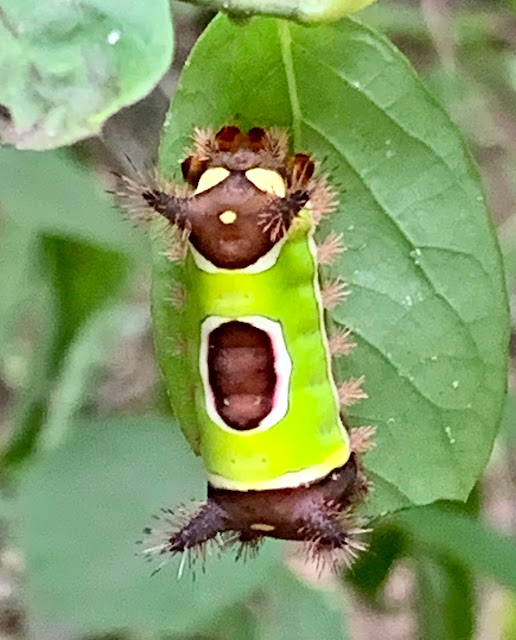A beautiful morning in Inwood Hill Park: bright blue sky with temperature around 50 at sunup. As usual, I started on the deck overlooking Muscota Marsh. I quickly spotted the usual mid-October birds found here recently: Song Sparrow, Swamp Sparrow and as in the last few days, Ruby-crowned Kinglet. The I saw another dark sparrow popup on the Spartina grasses. The bird was facing away from meand my first thought was another immature Swamp Sparrow. But something didn't look right: there seemed to be too much streaking underneath. For a second I considered Lincoln's Sparrow, but that didn't seem right either. Finally, the bird turned to face me and I realized I was looking at a Nelson's Sparrow, a bird I have long sought and expected to find at Muscota. I quickly started sending text messages out to other birders. I particularly wanted to reach Danny Karlson who I knew had headed over to the soccer field only a few minutes before I had arrived on the deck. Danny responded immediately that he was heading back. After dropping back out of sight for a couple of minutes, the Nelson's then came back up on top of the grass so that when I heard Danny behind me asking if the bird was still here, all I had to do was point! I was able to get some nice photos to document the sighting.


This was a new species for me for Inwood - my 222 species for the park. It came only three days after my last new park bird, a Vesper Sparrow found on the soccer fields on October 11 by Nadir Souirgi. It continued a good fall in the park - on September 25 I added American Bittern to my park list after Danny found it by the edge of the mudflats north of the soccer fields. Back on August 4 I had added four species including Sooty Tern when Tropical Storm Isaias hit NYC.
After watching the Nelson's for a while Danny and I headed over to the soccer field to see what we could find there. However, I turned around and went home to see if I could spot the bird from my apartment window and add it to the apartment list. I also rememebered that it was a life bird for Ann if I could get it for her from the window. The effort was successful and Ann saw the bird through a spotting scope. I was even able to digiscope it from the apartment window.

It was species # 119 for the apartment. It was also new for my New York County list: # 260.
Recently I have heard of people arguing for doing away with bird names that commemorate people. I personally find this a silly idea. I think birds that are named for people or places are an opportunity to learn some history. Having all birds named for some aspect of their plunage gets very boring and repetitive. And when birds have markedly different plumages based on the individual's sex, or age, or time of year, the name may not even be very helpful. In this spirit I decided to find out a bit about the namesake of Nelson's Sparrow. He turns out to have an impressive biography.
Edward William Nelson (1855- 1934): His father was killed in the Civil War. His mother's dressmaking business was destroyed in the Great Chicago Fire of 1871. When he was seventeen he went with some school friends on a trip to the Rocky Mountains led by the great 19th Century paleontologist and fossil collector Edward Drinker Cope. From 1877 to 1881 he explored and collected in Alaska. The field work in Alaska was so arduous that he suffered somewhat poor health from it for the rest of his life. Contracting tuberculosis after returning from Alaska didn't help either. In 1890-1891 he was on the US Biological Survey's Death Valley Expedition. Nelson went on to become President of the American Ornithologists Union (1908-1910) and Chief of the U.S. Biological Survey (1916-1927). In the latter capacity he negotiated the Migratory Bird Treaty between the U.S. and Canada. There are about 120 species and subspecies of mammals named for Nelson as well as two reptiles, five fish and two butterflies. On the coast of Alaska there is a Nelson's Island named for him. But before that distinuguished career, in 1874, when he was only 18 he collected the first specimen of a previously unknown sparrow at Calumet Lake in south Chicago. The ornithologist Joel A. Allen named the sparrow for Nelson when he described it in 1875.
Now, back to today's birds. Also down in Muscota Marsh this morning was an immature White-crowned Sparrow.
There have been a few of these around the park in the last week or so. In fact, the last ten days has been great for sparrows in the park. The Nelson's was the twelfth sparrow I have had in that time in the park. In addition to the Nelson's, White-crowned, and Vesper already mentioned I have found: Eastern Towhee, Chipping, Field, Savannah, Song, Lincoln's, Swamp, and White-throated sparrows, and Dark-eyed Junco.





































